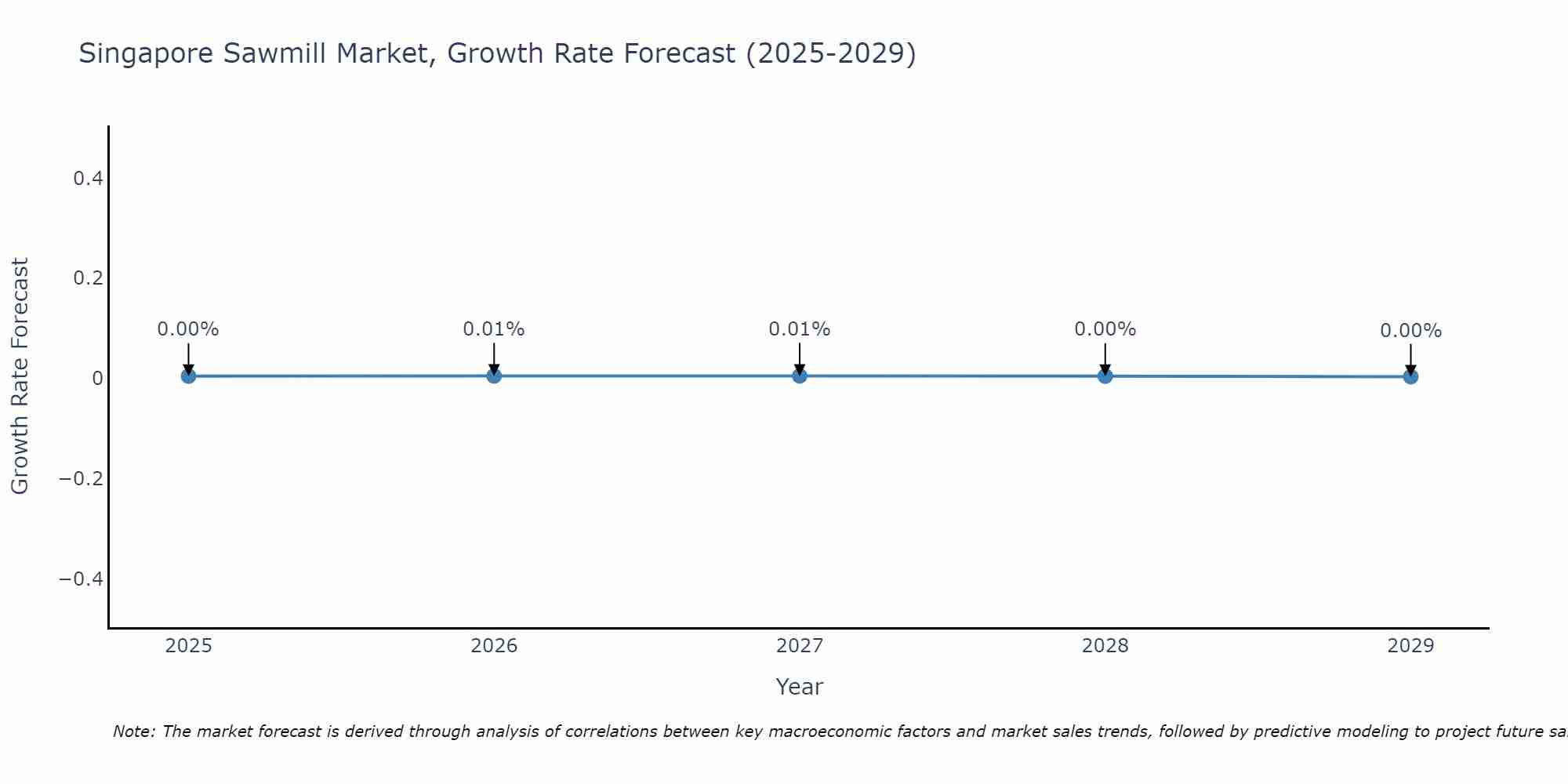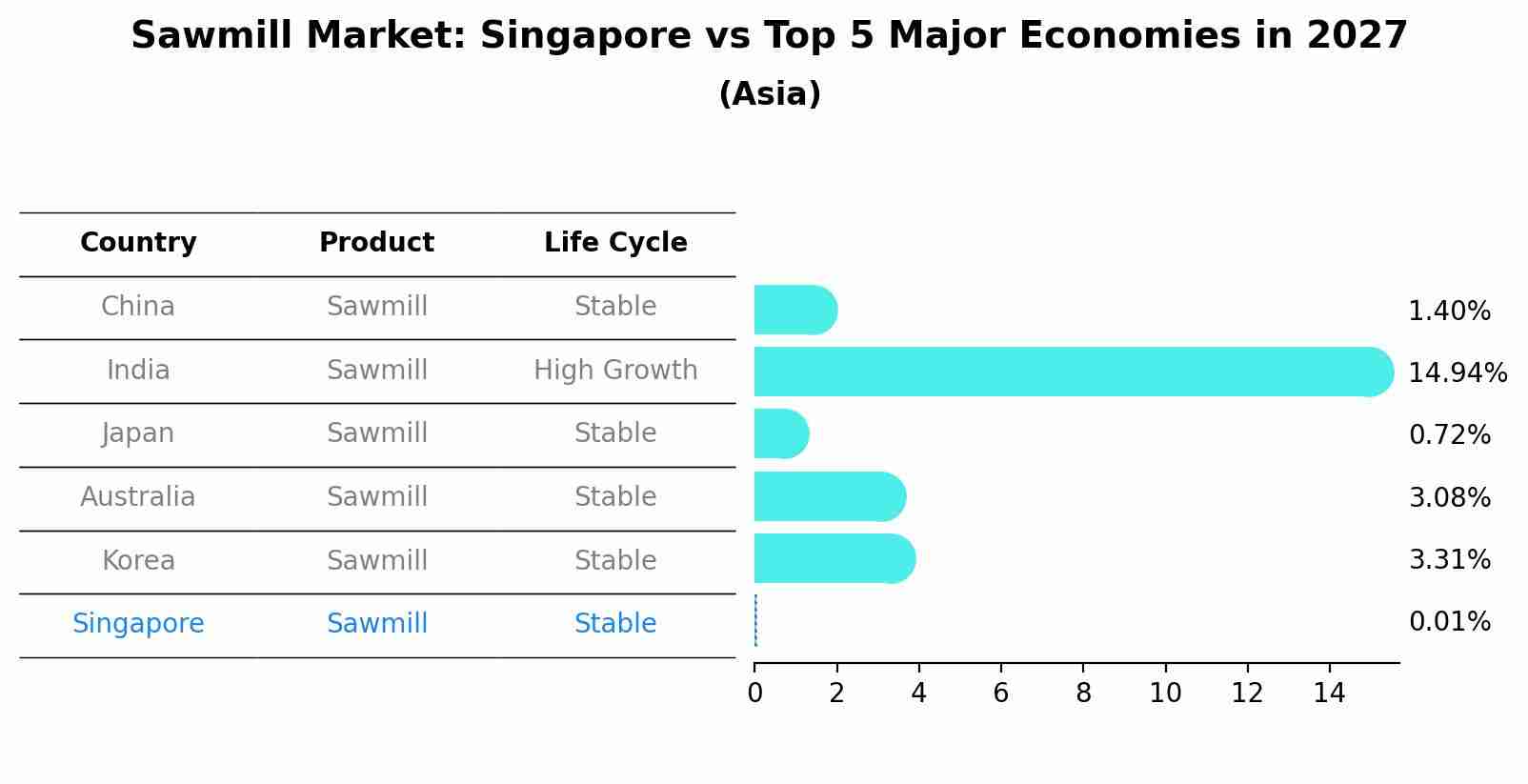Singapore Sawmill Market (2024-2030) | Outlook, Companies, Revenue, Size, Growth, Trends, Value, Analysis, Forecast, Share & Industry
| Product Code: ETC034967 | Publication Date: Jul 2023 | Updated Date: Apr 2025 | Product Type: Report | |
| Publisher: 6Wresearch | Author: Ravi Bhandari | No. of Pages: 70 | No. of Figures: 35 | No. of Tables: 5 |
Singapore Sawmill Market Size Growth Rate
The Singapore Sawmill Market is projected to witness mixed growth rate patterns during 2025 to 2029. Starting at 0.00% in 2025, the market peaks at 0.01% in 2027, and settles at 0.00% by 2029.

Sawmill Market: Singapore vs Top 5 Major Economies in 2027 (Asia)
By 2027, the Sawmill market in Singapore is anticipated to reach a growth rate of 0.01%, as part of an increasingly competitive Asia region, where China remains at the forefront, supported by India, Japan, Australia and South Korea, driving innovations and market adoption across sectors.

Singapore Sawmill Market Synopsis
The Singapore sawmill market is expected to grow at a healthy CAGR of 4.7% during the forecast period (2020-2026). This growth can be attributed to increasing demand for furniture, rising economic growth and government initiatives in the region. Increasing urbanization has led to increased consumption of wood products such as lumber, plywood, veneer and particleboard which are used in construction projects as well as for furniture manufacturing. The growing number of new housing projects especially in cities like Singapore and Kuala Lumpur will also help drive the demand for sawmills in this region.
Market Drivers
Growing Demand For Furniture ??? The increasing demand for furniture from residential applications driven by an expanding middle class population is driving growth in the sawmill market. As people aspire to live better lives with more comfort and convenience they are willing to invest more into home improvement leading to increased purchases of wooden furniture items such as tables, chairs, cabinets ETC, thus driving up the need for lumber produced by saw mills across Asia Pacific countries including Singapore. Rising Economic Growth ??? Rapid industrialization has been boosting economic activity across South East Asia???s developing economies leading towards higher disposable income levels amongst citizens resulting in greater spending on consumer goods including furniture thereby contributing towards robust revenue generation opportunities within the regional saw mill industry over 2020-2026 timeline.Government Initiatives - Sawmill operations within developed nations like Singapore have witnessed substantial support from both central & local governments via various programs that promote sustainable forestry practices & resource conservation measures that help create balanced ecosystems while supporting efficient production cycles within related industries including timber processing companies operating within this region.
Market challenges
High Cost Of Machinery And Equipment - Setting up a saw mill requires significant capital investments due high costs associated with machinery & equipment required along with other operational expenses such as labour charges, transportation fees ETC which could limit profit margins making it difficult efor small scale operators or first time entrepreneurs venture into this sector.
Key players
Major companies operating within this segment include Low & Behold Group Pte Ltd, RW Lee Timber Industries Pte Ltd.
Covid-19 Impact
The COVID 19 pandemic has had a negative impact on the global economy across various sectors including but not limited to travel & tourism, automotive, retail.The same goes for this sector too since it relies heavily upon manual labour along with high input costs.This has caused an interruption in supply chain operations because of widespread lockdowns causing disruption in trade activities leading at times even forcing businesses into closing down temporarily or permanently depending upon their financial resources.However, recovery can be expected once normalcy resumes provided government policies continue supporting businesses.
Key Highlights of the Report:
- Singapore Sawmill Market Outlook
- Market Size of Singapore Sawmill Market, 2023
- Forecast of Singapore Sawmill Market, 2030
- Historical Data and Forecast of Singapore Sawmill Revenues & Volume for the Period 2020-2030
- Singapore Sawmill Market Trend Evolution
- Singapore Sawmill Market Drivers and Challenges
- Singapore Sawmill Price Trends
- Singapore Sawmill Porter's Five Forces
- Singapore Sawmill Industry Life Cycle
- Historical Data and Forecast of Singapore Sawmill Market Revenues & Volume By Product Type for the Period 2020-2030
- Historical Data and Forecast of Singapore Sawmill Market Revenues & Volume By Softwood Lumber for the Period 2020-2030
- Historical Data and Forecast of Singapore Sawmill Market Revenues & Volume By Hardwood Lumber for the Period 2020-2030
- Historical Data and Forecast of Singapore Sawmill Market Revenues & Volume By Application for the Period 2020-2030
- Historical Data and Forecast of Singapore Sawmill Market Revenues & Volume By Construction for the Period 2020-2030
- Historical Data and Forecast of Singapore Sawmill Market Revenues & Volume By Furniture for the Period 2020-2030
- Historical Data and Forecast of Singapore Sawmill Market Revenues & Volume By Packaging and Joinery Industries for the Period 2020-2030
- Historical Data and Forecast of Singapore Sawmill Market Revenues & Volume By Others for the Period 2020-2030
- Singapore Sawmill Import Export Trade Statistics
- Market Opportunity Assessment By Product Type
- Market Opportunity Assessment By Application
- Singapore Sawmill Top Companies Market Share
- Singapore Sawmill Competitive Benchmarking By Technical and Operational Parameters
- Singapore Sawmill Company Profiles
- Singapore Sawmill Key Strategic Recommendations
Frequently Asked Questions About the Market Study (FAQs):
1 Executive Summary |
2 Introduction |
2.1 Key Highlights of the Report |
2.2 Report Description |
2.3 Market Scope & Segmentation |
2.4 Research Methodology |
2.5 Assumptions |
3 Singapore Sawmill Market Overview |
3.1 Singapore Country Macro Economic Indicators |
3.2 Singapore Sawmill Market Revenues & Volume, 2020 & 2030F |
3.3 Singapore Sawmill Market - Industry Life Cycle |
3.4 Singapore Sawmill Market - Porter's Five Forces |
3.5 Singapore Sawmill Market Revenues & Volume Share, By Product Type, 2020 & 2030F |
3.6 Singapore Sawmill Market Revenues & Volume Share, By Application, 2020 & 2030F |
4 Singapore Sawmill Market Dynamics |
4.1 Impact Analysis |
4.2 Market Drivers |
4.3 Market Restraints |
5 Singapore Sawmill Market Trends |
6 Singapore Sawmill Market, By Types |
6.1 Singapore Sawmill Market, By Product Type |
6.1.1 Overview and Analysis |
6.1.2 Singapore Sawmill Market Revenues & Volume, By Product Type, 2020-2030F |
6.1.3 Singapore Sawmill Market Revenues & Volume, By Softwood Lumber, 2020-2030F |
6.1.4 Singapore Sawmill Market Revenues & Volume, By Hardwood Lumber, 2020-2030F |
6.2 Singapore Sawmill Market, By Application |
6.2.1 Overview and Analysis |
6.2.2 Singapore Sawmill Market Revenues & Volume, By Construction, 2020-2030F |
6.2.3 Singapore Sawmill Market Revenues & Volume, By Furniture, 2020-2030F |
6.2.4 Singapore Sawmill Market Revenues & Volume, By Packaging and Joinery Industries, 2020-2030F |
6.2.5 Singapore Sawmill Market Revenues & Volume, By Others, 2020-2030F |
7 Singapore Sawmill Market Import-Export Trade Statistics |
7.1 Singapore Sawmill Market Export to Major Countries |
7.2 Singapore Sawmill Market Imports from Major Countries |
8 Singapore Sawmill Market Key Performance Indicators |
9 Singapore Sawmill Market - Opportunity Assessment |
9.1 Singapore Sawmill Market Opportunity Assessment, By Product Type, 2020 & 2030F |
9.2 Singapore Sawmill Market Opportunity Assessment, By Application, 2020 & 2030F |
10 Singapore Sawmill Market - Competitive Landscape |
10.1 Singapore Sawmill Market Revenue Share, By Companies, 2023 |
10.2 Singapore Sawmill Market Competitive Benchmarking, By Operating and Technical Parameters |
11 Company Profiles |
12 Recommendations |
13 Disclaimer |
- Single User License$ 1,995
- Department License$ 2,400
- Site License$ 3,120
- Global License$ 3,795
Search
Thought Leadership and Analyst Meet
Our Clients
Related Reports
- Germany Breakfast Food Market (2026-2032) | Industry, Share, Growth, Size, Companies, Value, Analysis, Revenue, Trends, Forecast & Outlook
- Australia Briquette Market (2025-2031) | Growth, Size, Revenue, Forecast, Analysis, Trends, Value, Share, Industry & Companies
- Vietnam System Integrator Market (2025-2031) | Size, Companies, Analysis, Industry, Value, Forecast, Growth, Trends, Revenue & Share
- ASEAN and Thailand Brain Health Supplements Market (2025-2031) | Strategy, Consumer Insights, Analysis, Investment Trends, Opportunities, Growth, Size, Share, Industry, Revenue, Segments, Value, Segmentation, Supply, Forecast, Restraints, Outlook, Competition, Drivers, Trends, Demand, Pricing Analysis, Competitive, Strategic Insights, Companies, Challenges
- ASEAN Bearings Market (2025-2031) | Strategy, Consumer Insights, Analysis, Investment Trends, Opportunities, Growth, Size, Share, Industry, Revenue, Segments, Value, Segmentation, Supply, Forecast, Restraints, Outlook, Competition, Drivers, Trends, Demand, Pricing Analysis, Competitive, Strategic Insights, Companies, Challenges
- Europe Flooring Market (2025-2031) | Outlook, Share, Industry, Trends, Forecast, Companies, Revenue, Size, Analysis, Growth & Value
- Saudi Arabia Manlift Market (2025-2031) | Outlook, Size, Growth, Trends, Companies, Industry, Revenue, Value, Share, Forecast & Analysis
- Uganda Excavator, Crane, and Wheel Loaders Market (2025-2031) | Strategy, Consumer Insights, Analysis, Investment Trends, Opportunities, Growth, Size, Share, Industry, Revenue, Segments, Value, Segmentation, Supply, Forecast, Restraints, Outlook, Competition, Drivers, Trends, Demand, Pricing Analysis, Competitive, Strategic Insights, Companies, Challenges
- Rwanda Excavator, Crane, and Wheel Loaders Market (2025-2031) | Strategy, Consumer Insights, Analysis, Investment Trends, Opportunities, Growth, Size, Share, Industry, Revenue, Segments, Value, Segmentation, Supply, Forecast, Restraints, Outlook, Competition, Drivers, Trends, Demand, Pricing Analysis, Competitive, Strategic Insights, Companies, Challenges
- Kenya Excavator, Crane, and Wheel Loaders Market (2025-2031) | Strategy, Consumer Insights, Analysis, Investment Trends, Opportunities, Growth, Size, Share, Industry, Revenue, Segments, Value, Segmentation, Supply, Forecast, Restraints, Outlook, Competition, Drivers, Trends, Demand, Pricing Analysis, Competitive, Strategic Insights, Companies, Challenges
Industry Events and Analyst Meet
Whitepaper
- Middle East & Africa Commercial Security Market Click here to view more.
- Middle East & Africa Fire Safety Systems & Equipment Market Click here to view more.
- GCC Drone Market Click here to view more.
- Middle East Lighting Fixture Market Click here to view more.
- GCC Physical & Perimeter Security Market Click here to view more.
6WResearch In News
- Doha a strategic location for EV manufacturing hub: IPA Qatar
- Demand for luxury TVs surging in the GCC, says Samsung
- Empowering Growth: The Thriving Journey of Bangladesh’s Cable Industry
- Demand for luxury TVs surging in the GCC, says Samsung
- Video call with a traditional healer? Once unthinkable, it’s now common in South Africa
- Intelligent Buildings To Smooth GCC’s Path To Net Zero


















